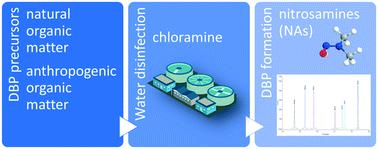当前位置:
X-MOL 学术
›
Environ. Sci.: Water Res. Technol.
›
论文详情
Our official English website, www.x-mol.net, welcomes your
feedback! (Note: you will need to create a separate account there.)
Occurrence of N-nitrosamines and their precursors in Spanish drinking water treatment plants and distribution systems
Environmental Science: Water Research & Technology ( IF 3.5 ) Pub Date : 2019-11-14 , DOI: 10.1039/c9ew00912d Maria José Farré 1, 2, 2, 3, 4 , Sara Insa 1, 2, 2, 3, 4 , Aaron Lamb 5, 6, 7 , Cristian Cojocariu 5, 6, 7 , Wolfgang Gernjak 1, 2, 3, 8, 9
Environmental Science: Water Research & Technology ( IF 3.5 ) Pub Date : 2019-11-14 , DOI: 10.1039/c9ew00912d Maria José Farré 1, 2, 2, 3, 4 , Sara Insa 1, 2, 2, 3, 4 , Aaron Lamb 5, 6, 7 , Cristian Cojocariu 5, 6, 7 , Wolfgang Gernjak 1, 2, 3, 8, 9
Affiliation

|
N-Nitrosamines are carcinogenic compounds that can be formed during disinfection processes as by-products in drinking and recycled water systems. Among them, N-nitrosodimethylamine (NDMA) is of particular interest, especially in systems employing chloramines, because its presence is regulated in various countries. Although there is a lot of emphasis on NDMA due to its toxicity, there may be other N-nitrosamines formed during disinfection processes that pose similar or higher toxicities and are currently scarcely studied. This work investigates the presence of NDMA and six additional N-nitrosamines in different drinking water treatment plants (DWTPs) and strategic sampling points from drinking water networks in Spain that employ monochloramines. The other N-nitrosamines investigated are N-nitrosodiethylamine (NDEA), N-nitrosomethylamine (NMEA), N-nitrosodibutylamine (NDBA), N-nitrosopiperidine (NPIP), N-nitrosodipropylamine (NDPA) and N-nitrosopyrrolidine (NPYR). Moreover, the fate of N-nitrosamine precursors was measured across different DWTPs. The actual concentration of NDMA in the final treated water and samples taken from the distribution system was never above 4.2 ± 0.2 ng L−1. NDEA and NDBA were also detected in almost all samples, however, their concentrations did not exceed 1.5 ng L−1 in any case. The maximum concentration of NDMA formation potential following chloramination was 41.5 ± 4.3 ng L−1. The concentration of other N-nitrosamines originating during NDMA formation potential tests was lower than 3 ng L−1. Among the studied DWTPs, those that included ozone followed by granular activated carbon (GAC) in the treatment train removed NDMA formation potential best, showing that this can be an efficient strategy to control NDMA formation during drinking water production when chloramines are used in the distribution systems.
中文翻译:

N-亚硝胺及其前体在西班牙饮用水处理厂和分配系统中的发生
N-亚硝胺是致癌化合物,可在消毒过程中作为饮用水和循环水系统中的副产物形成。其中,N-亚硝基二甲胺(NDMA)特别受关注,特别是在使用氯胺的系统中,因为在许多国家/地区对N-亚硝基二甲胺的存在都有规定。尽管由于NDMA的毒性,人们对NDMA的重视程度很高,但在消毒过程中可能还会形成其他N-亚硝胺,它们具有相似或更高的毒性,目前很少进行研究。这项工作调查了NDMA和另外六个N的存在西班牙的不同饮用水处理厂(DWTP)中的亚硝胺和采用单氯胺的西班牙饮用水网络中的战略采样点。研究的其他N-亚硝胺是N-亚硝基二乙胺(NDEA),N-亚硝基甲胺(NMEA),N-亚硝基二丁胺(NDBA),N-亚硝基哌啶(NPIP),N-亚硝基二丙胺(NDPA)和N-亚硝基吡咯烷(NPYR)。此外,跨不同的DWTP测量了N-亚硝胺前体的结局。从分配系统中抽取的最终处理过的水和样品中NDMA的实际浓度从未超过4.2±0.2 ng L -1。在几乎所有样品中也检测到NDEA和NDBA,但是无论如何它们的浓度均不超过1.5 ng L -1。氯化后NDMA形成潜能的最大浓度为41.5±4.3 ng L -1。在NDMA形成电势测试期间源自其他N-亚硝胺的浓度低于3 ng L -1。在所研究的DWTP中,那些在处理过程中包含臭氧和颗粒状活性炭(GAC)的DWTP最好地消除了NDMA的形成潜力,这表明当在分配过程中使用氯胺时,这可能是控制饮用水生产过程中NDMA形成的有效策略。系统。
更新日期:2019-11-14
中文翻译:

N-亚硝胺及其前体在西班牙饮用水处理厂和分配系统中的发生
N-亚硝胺是致癌化合物,可在消毒过程中作为饮用水和循环水系统中的副产物形成。其中,N-亚硝基二甲胺(NDMA)特别受关注,特别是在使用氯胺的系统中,因为在许多国家/地区对N-亚硝基二甲胺的存在都有规定。尽管由于NDMA的毒性,人们对NDMA的重视程度很高,但在消毒过程中可能还会形成其他N-亚硝胺,它们具有相似或更高的毒性,目前很少进行研究。这项工作调查了NDMA和另外六个N的存在西班牙的不同饮用水处理厂(DWTP)中的亚硝胺和采用单氯胺的西班牙饮用水网络中的战略采样点。研究的其他N-亚硝胺是N-亚硝基二乙胺(NDEA),N-亚硝基甲胺(NMEA),N-亚硝基二丁胺(NDBA),N-亚硝基哌啶(NPIP),N-亚硝基二丙胺(NDPA)和N-亚硝基吡咯烷(NPYR)。此外,跨不同的DWTP测量了N-亚硝胺前体的结局。从分配系统中抽取的最终处理过的水和样品中NDMA的实际浓度从未超过4.2±0.2 ng L -1。在几乎所有样品中也检测到NDEA和NDBA,但是无论如何它们的浓度均不超过1.5 ng L -1。氯化后NDMA形成潜能的最大浓度为41.5±4.3 ng L -1。在NDMA形成电势测试期间源自其他N-亚硝胺的浓度低于3 ng L -1。在所研究的DWTP中,那些在处理过程中包含臭氧和颗粒状活性炭(GAC)的DWTP最好地消除了NDMA的形成潜力,这表明当在分配过程中使用氯胺时,这可能是控制饮用水生产过程中NDMA形成的有效策略。系统。









































 京公网安备 11010802027423号
京公网安备 11010802027423号